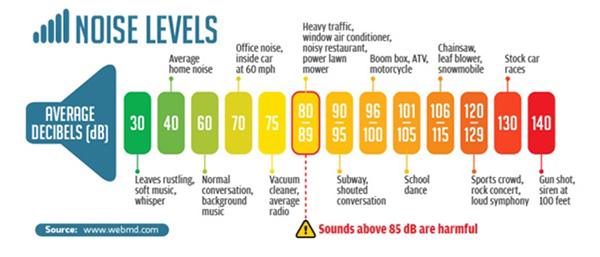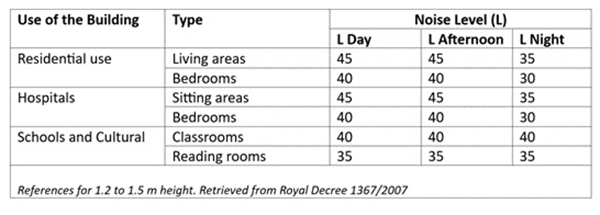In our fast-paced world where noise is a constant, quiet is a luxury. It is possible to create a quiet oasis to recharge one’s batteries by insulating your home. Air brings with it noise, so by reducing air infiltration and sealing the house, you are well on the way to a quieter space.
What is sound?
Noise level is measured in decibels (dB). The louder the noise, the higher the decibels. But noise does not increase in a straight line. Each 10dB increase is an increase of sound by ten times, e.g., a sound at 20dB has ten times more energy than at 10dB. And a sound at 30dB has 10x10 (so 100 times) more energy than at 10dB. Or maybe an easier way to calculate: every 3dB increase is approximately a doubling of the sound intensity or acoustic power.
But our ears hear sound differently. The normal range of hearing extends from 0dB (hearing threshold) to around 130dB (pain threshold). A difference of 10dB halves/doubles the noise, e.g., if the sound pressure level was increased by 10dB, then we would feel that the sound was twice as loud, so a noise increase from 60dB to 70dB would seem to have doubled. If it was reduced by 10dB from 60dB to 50dB, then we would feel that the noise had halved.

Health impacts
Exposure to unwanted noise increases stress levels, which can lead to raised heart rate and blood pressure, especially through noise exposure at night. Noise can disrupt sleeping patterns and create learning difficulties. Environmental noise is recognised by the World Health Organisation (WHO) as harmful pollution, which causes adverse effects on health.
There is also ‘noise annoyance’, which is a negative emotional response to noise pollution that can create irritation, disturbance and dissatisfaction. Road traffic noise and aircraft noise can even affect children’s learning as a UK study found.

Acoustic quality goals for noise levels inside buildings for residential use, hospitals, schools and cultural centres
Quiet windows
Be it noisy neighbours or street and traffic sounds, much of the noise that enters our homes comes in through windows. By using high-performance windows and doors in new builds or renovations, you are well on the way to create a quiet home. Special noise cancelling glazing is also available, and in double glazing two different thicknesses of glass should be used to capture different wave lengths.
Window installation is very important to stop noise. There cannot be any gaps between window and building envelope at all, as these will allow noise to enter. Sound penetrates even through the smallest gaps; therefore, sound blocking measures such as using expandable foam and/or tapes are a must.
Can sound be absorbed?
Soft furnishings such as carpets, rugs, wall hangings etc., have noise absorption capabilities. Even furniture and books can help to reduce noise, and so can window furnishings like curtains and drapes.
White noise
Research indicates that introducing white noise can effectively mask other noises and allow people to go to sleep easier and better. By emitting a consistent sound, they create a gentle background noise that drowns out sudden disturbances, such as traffic sounds or barking dogs.
Ready for quiet windows with no noise and no draft? Contact us for more information.
Sources include: The Conversation and ResearchGate

